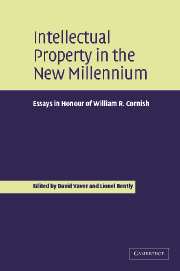Book contents
- Frontmatter
- Contents
- List of contributors
- Foreword
- Preface
- General intellectual property
- Patents and plant protection
- Trade marks and unfair competition
- Copyright, moral and neighbouring rights
- 15 The Berne Convention: the continued relevance of an ancient text
- 16 The (new?) right of making available to the public
- 17 Private copy licence and levy schemes: resolving the paradox of civilian and common law approaches
- 18 Paternalism and autonomy in copyright contracts
- 19 Criminality and copyright
- 20 Towards new forms of neighbouring rights within the European Union?
- William R. Cornish – curriculum vitae
- Index
20 - Towards new forms of neighbouring rights within the European Union?
Published online by Cambridge University Press: 25 May 2010
- Frontmatter
- Contents
- List of contributors
- Foreword
- Preface
- General intellectual property
- Patents and plant protection
- Trade marks and unfair competition
- Copyright, moral and neighbouring rights
- 15 The Berne Convention: the continued relevance of an ancient text
- 16 The (new?) right of making available to the public
- 17 Private copy licence and levy schemes: resolving the paradox of civilian and common law approaches
- 18 Paternalism and autonomy in copyright contracts
- 19 Criminality and copyright
- 20 Towards new forms of neighbouring rights within the European Union?
- William R. Cornish – curriculum vitae
- Index
Summary
Over the last 15 years the process of European harmonisation of copyright and related rights resulted in the introduction of new forms of protection, subject-matter or rights within the legislation of EC Member States, thus expanding the scope of intellectual property to an unprecedented level. At the time of their harmonisation, most of these rights were already implemented in a number of Member States, and were simply extended to other jurisdictions in this process.
This choice to harmonise upwards, to the highest existing standard, can be explained by the legitimate concern expressed by the European institutions not to deprive rights owners in certain Member States of part of their existing rights, otherwise protected under the Treaty.
However, as a result most of these extensions and additions lack the careful practical and economic analysis associated with similar extensions of copyright over its long history. What took under traditional copyright law decades to implement, with long doctrinal and judicial debates, was regulated at the European level over ten years and, in some cases, with very little discussion.
The extension of the term of copyright and related rights is typical of this attitude. As Professor Dworkin pointed out, ‘there has been remarkably little detailed examination of the policy considerations applicable to the determination of appropriate periods of protection either for copyright or for related rights’. Recital 5 of the Term Directive merely stated that the term was no longer sufficient to cover two generations, which is simply wrong.
- Type
- Chapter
- Information
- Intellectual Property in the New MillenniumEssays in Honour of William R. Cornish, pp. 280 - 288Publisher: Cambridge University PressPrint publication year: 2004

